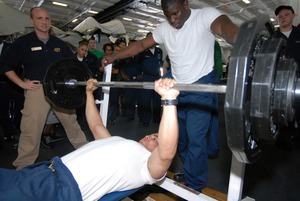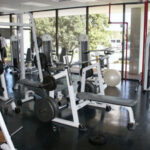To prevent bench press injuries you need a proper warm-up. I’m a certified personal trainer. I often see men diving right into the bench press without warming up.
I’ve seen them enter the gym and head straight for the bench press, so that’s how I know. Or they exit the locker room and it’s obvious they haven’t worked out yet, and the first thing they do is load the bench press with heavy weights ‘” not their warm-up weights, because they strain to do these first sets.
Warm-ups and general routine for the bench press: You should devote 10 or more minutes to warming up for serious lifting. This exercise is very hard on the shoulder joints, and though the chest muscles may be ready to go, the rotator cuff muscles and their tendons may still be lagging behind and need more warm-up time.
The pectoralis muscles do not act alone in the bench press. Other structures need to be strong enough to assist the pecs. And one of these structures is the subscapularis – one of the four rotator cuff muscles.
It contributes to shoulder internal rotation, which is also one of the functions of the pectoralis major muscle. But if, in general, the rotator cuff group is weak, this will interfere with your bench press progress.
And because the anterior deltoids are secondary movers for this compound routine, warm-ups should include some light shoulder work as well.
1. First gently stretch the shoulders.
2. Shoulder lateral lifts. You may wonder how shoulder lateral lifts (lifting dumbbells up and out to your sides with an almost-straight arm) can aid in the bench press. Lateral lifts will loosen up the joint, and maybe get all the “creaks” out, and increase blood flow in the shoulders. Make sure that you use weight light enough to easily get through 20 reps with a controlled lowering of the dumbbells. Two sets.
3. Incline dumbbell presses; 20 reps, two sets.
4. Start bench pressing, but go light enough for 20 reps. Increase weight accordingly to hit 15, 12, and then 8 reps.
5. You are now ready to attempt 6-10-rep maxes, 4-5 sets. After the first three sets, rest five minutes, plus drink water and include more shoulder stretching. The five-minute rest will recharge the muscles.
6. If you are already doing something very similar to all of this, then add the following variables: supersets such as dumbbell, seated chest or incline barbell presses; longer rest in between sets; use a slightly inclined bench; and/or change distance between hands on the bar. If hands are too close, more triceps will be recruited, and triceps aren’t as strong as chest muscles.
If you still see no progress after a trial period, then drop back to 2-3 heavy sets. A rotator cuff injury will set your bench press routine back many months, so don’t neglect a warm-up every time.





